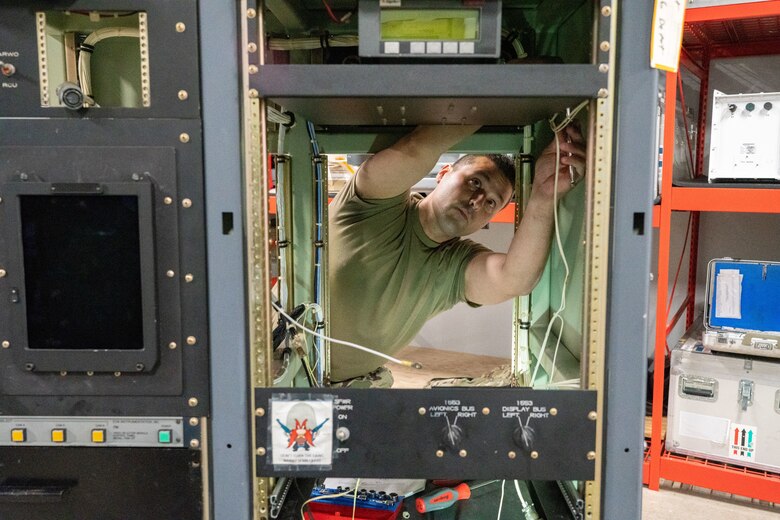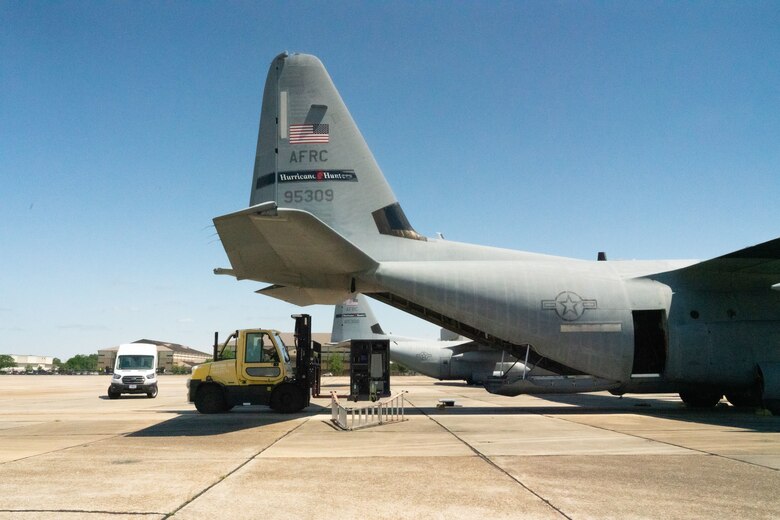The 53rd Weather Reconnaissance Squadron "Hurricane Hunters" aerial reconnaissance weather officer and loadmaster/dropsonde operator stations are being upgraded with hardware and software to increase their weather collecting capabilities.
"The (Meteorology Equipment Technician) shop is in the middle of a system upgrade, specifically on the ARWO station," said Maj. Tobi Baker, 53rd WRS ARWO. "It's a major overhaul because the hardware and software that we use is specialized and a lot of the programs and components are made in-house."
The Hurricane Hunters are the only Department of Defense unit that flies into storm environments to gather atmospheric data with the use of instruments in and outside of their weather specialized WC-130J Super Hercules aircraft.
With such a specialized mission, there is a specialized shop of Reserve Airmen from the 403rd Maintenance Squadron that maintain the hurricane hunting equipment, and they are the meteorology equipment technicians.
"This upgrade on the ARWO pallet and in regards to the hardware, software and development, to include replacing the monitors to keep up with the new information and data processing, are vital to keeping us up-to-date with the weather community," said Tech. Sgt. Michael Gehl, 403rd MXS meteorology technician. "We work hand-in-hand with engineers and developers from the 580th (Software Engineering Squadron) and (Air Force Reserve Command) for testing and developing any of the equipment that the weather community requests."
Gehl said that about 75% of the work is in the shop dealing with aircraft engineers, upgrading and repairing components, and visiting the National Hurricane Center for preventative maintenance on ground equipment as well as at any forward deployed ground stations.
One of the primary upgrades being implemented is the computer operating system, which is going from Windows XP to Windows 10.
"To give you a sense of time, the computers on the ARWO pallet were brand new in 2005 and now they're all being updated to the current technology," said Master Sgt. Alexander Mitchell, 403rd MXS MET noncommissioned officer in charge. "Originally we were in the middle of upgrading from XP to Windows 7, but due to Air Force's Windows 10 compliance, it delayed us in testing and implementing that software and hardware in 2018."
The 15 year gap in technological difference restarted the upgrade process because the specialized weather software had to be rewritten for the new operating system, Mitchell said.
"Our maintainers have to take something working from XP to 10. It's a dynamic database that's taking information native from the pilot instruments, sensors on the plane, while at the same time taking information from the load pallet and then transmitting the data to the NHC," Baker said. "With these upgrades we'll have approximately 25% increase in computer processing power, which means a more efficient flow of data that leads to better quality of data, and that will help the forecast."
A large portion of the upgrade process has been the testing phase to ensure the components are robust enough to pass airworthiness and working out the glitches, Gehl said.
"We need reliability. You cannot take a common computer off the shelf and slap it into the aircraft because testing must be done first, in addition to a lot of the software and hardware components made in-house" Baker said. "The reason it needs to be tested is due to aircraft vibrations and the rigors of flying, such as takeoffs and landings in addition to working around the clock."
In addition to the ARWO station the loadmaster pallet is getting its equipment updated as well to increase its tracking capabilities, the biggest being its display.
"The loadmaster pallets are also getting new (Color Multi-Display Units), which we have no more replacements for," Mitchell said. "We've researched and found a suitable replacement at a cheaper cost, which has saved the Air Force approximately $1.9 million compared to using the same original brand CMDUs we used in the past."
Baker said these upgrades are necessary to keep up with new technology and also leaves room for potentially new weather gathering radar and sensors in the future.
"This has been a team effort from our maintainers to the engineers and software developers from the Air Force Lifecycle Management Center and the 580th Software Engineering Squadron," Baker said. "Without them, this couldn't have been done.
The total force effort currently has the upgrade process in its final stages and the installation process for the 10 WC-130Js will begin immediately after headquarters signs off on the approval, right in time for hurricane season.
"These upgrades are extremely important because it will increase our efficiency and overall mission effectiveness," Baker said. "Collecting weather data is like collecting puzzle pieces, the more pieces we have the better picture we can help create for the forecasters."

Senior Airman Warren Reynier, 403rd Maintenance Squadron meteorology technician, works on the internal wiring of the aerial reconnaissance weather officer station at Keesler Air Force Base, Miss., May 12, 2021. The 53rd Weather Reconnaissance Squadron "Hurricane Hunters'" ARWO and loadmaster/dropsonde operator stations are being upgraded with hardware and software to increase their weather collecting capabilities. (U.S. Air Force photo by 2nd Lt. Christopher Carranza)

Master Sgt. Robert Ramos, 403rd Maintenance Squadron avionics flight chief, operates the forklift loading an aerial weather officer station onto a WC-130J Super Hercules aircraft at Keesler Air Force Base, Miss., May 13, 2021. The 53rd Weather Reconnaissance Squadron, "Hurricane Hunters," ARWO and loadmaster/dropsonde operator stations are being upgraded with hardware and software to increase their weather collecting capabilities. (U.S. Air Force photo by 2nd Lt. Christopher Carranza)






